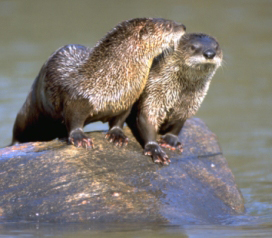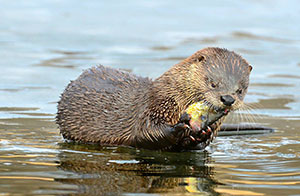 River otters (Lontra canadensis) are now found throughout most of Indiana, thanks to efforts of the DNR and its partners. In 1995, the DNR began a reintroduction program aimed at re-establishing a healthy otter population in several watersheds of northern and southern Indiana. After five years of reintroductions, the otter population began to expand through natural reproduction. The otter was removed from the state-endangered species list in 2005. Since that time, otters have been reported in every Indiana county, far surpassing reintroduction goals. The population continues to expand.
River otters (Lontra canadensis) are now found throughout most of Indiana, thanks to efforts of the DNR and its partners. In 1995, the DNR began a reintroduction program aimed at re-establishing a healthy otter population in several watersheds of northern and southern Indiana. After five years of reintroductions, the otter population began to expand through natural reproduction. The otter was removed from the state-endangered species list in 2005. Since that time, otters have been reported in every Indiana county, far surpassing reintroduction goals. The population continues to expand.
Are you a paddler interested in helping conserve and manage wildlife for future generations? Consider volunteering for the Paddlecraft Wildlife Index.
General characteristics
- Otters have a long body, short legs and muscular neck.
- Fur color is typically medium to dark brown on top with a lighter chest and belly.
- Otters have long, thick whiskers and webbed feet.
- Weights range from 11 to 20 pounds.
- Otters can hold their breath for 8 minutes.
- Their fur repels water.
- Otters are most active at night and at dawn and dusk.
Similar species
Distribution and abundance
A total of 303 river otters were released in northern and southern Indiana between 1995 and 1999.
The reintroduction went so well that the river otter was removed from the state-endangered list in 2005. River otter reports have been documented in most counties in Indiana and river otter will likely be statewide, though in some places at low densities in the next several years. Each year, DNR staff collect samples from river otter carcasses for population monitoring.
Reproduction
River otters are polygynous (have several mates). Most river otters will start reproducing at 2 years old. Otters typically breed from December to April and gestation is 61–63 days. Otters also delay implantation at least 8 months, meaning birth may not occur until 10 to 12 months after copulation. Litter size is typically one to three kits, however they can range up to five. The female otter raises the young without aid from the adult males. Young are born between February–April and can leave the den within eight weeks of birth.
Food habits 
River otters spend most of their lives in water, which reflects in their diet.
Primary foods include:
- Fish
- Crayfish
- Mussels
- Frogs, salamanders, and turtles
- Ducks and other birds
Though primarily carnivores, river otters have been documented eating fruit on rare occasions.
Viewing Tips
River otters inhabit many of Indiana’s lakes, rivers, and creeks. They are most commonly seen at dawn and dusk, so an evening or early morning paddle on one of Indiana’s water trails can be a great way to try to spot a river otter. Although they don’t maintain set territories or have distinguishable homes like beaver and muskrats, they do leave behind signs that they were there, in the form of latrines. Latrines are places, usually on low sandy areas with easy access to the water, where otters return to leave their poop, or scat. If you find an otter latrine while hiking or paddling, it means that river otters are in the area and might be frolicking through the water. River otters are a common sight at Muscatatuck National Wildlife Refuge and can be seen bouncing in and between many of the pits and lakes of Sugar Ridge Fish & Wildlife Area.
Management and control
River otters and human conflicts
River otters can cause damage, especially to small fish ponds or fish hatcheries. If a landowner has otter damage occurring during trapping season, their best option is to allow a licensed trapper property access to try to alleviate the damage. Outside of the trapping season, landowners can contact the DNR to obtain a nuisance wildlife animal control permit. Otter damage in ponds can be reduced by providing adequate structure to give fish ample places to hide from predators like otter. Electric or welded-wire fencing can also be effective, depending on the size of the pond or hatchery.
If you would like a permit to remove a river otter causing a conflict, you must submit a nuisance wildlife control permit application before a permit will be issued.
Management
A limited river otter trapping season was started in 2015 after otters had greatly expanded in Indiana. The season is highly regulated, with mandatory 24-hour reporting, tagging requirements, season bag limits, and a season quota. Learn more about the river otter trapping season. River otters are tracked through several surveys, including harvest monitoring and monitoring incidental captures, as well as the Paddlecraft Wildlife Index. Reports from various surveys and monitoring are available on the wildlife reports page .
